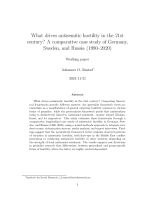What drives antisemitic hostility in the 21st century? A comparative case study of Germany, Sweden, and Russia (1990–2020)
Author(s)
Publication Date
Abstract
What drives antisemitic hostility in the 21st century? Competing theoretical frameworks provide different answers: the generalist framework views antisemitism as a manifestation of general outgroup hostility common to various
forms of prejudice, while the particularist framework posits that antisemitism today is distinctively linked to antizionist sentiment—enmity toward Zionism, Israel, and its supporters. This study evaluates these frameworks through a comparative, longitudinal case study of antisemitic hostility in Germany, Sweden, and Russia (1990–2020), using a mixed-methods approach to integrate incident counts, victimization surveys, media analysis, and expert interviews. Findings suggest that the particularist framework better explains observed patterns of variation in antisemitic hostility, with flare-ups in the Middle East conflict generating or catalyzing antisemitic hostility in other societies depending on the strength of local antizionist sentiment. The results support new directions
in prejudice research that differentiate between generalized and group-specific forms of hostility, where the latter are highly context-dependent.
forms of prejudice, while the particularist framework posits that antisemitism today is distinctively linked to antizionist sentiment—enmity toward Zionism, Israel, and its supporters. This study evaluates these frameworks through a comparative, longitudinal case study of antisemitic hostility in Germany, Sweden, and Russia (1990–2020), using a mixed-methods approach to integrate incident counts, victimization surveys, media analysis, and expert interviews. Findings suggest that the particularist framework better explains observed patterns of variation in antisemitic hostility, with flare-ups in the Middle East conflict generating or catalyzing antisemitic hostility in other societies depending on the strength of local antizionist sentiment. The results support new directions
in prejudice research that differentiate between generalized and group-specific forms of hostility, where the latter are highly context-dependent.
Topics
Antisemitism: Attitude Surveys Antisemitism Antisemitism: Monitoring Longitudinal Studies Main Topic: Antisemitism Statistics Surveys
Genre
Geographic Coverage
Copyright Info
CC-By Attribution 4.0 International
Original Language
DOI
Link
Bibliographic Information
What drives antisemitic hostility in the 21st century? A comparative case study of Germany, Sweden, and Russia (1990–2020). 2024: https://archive.jpr.org.uk/10.31219/osf.io/2x6ws




